Ergon Energy: Supply Chain Operations Analysis and Sustainability
VerifiedAdded on 2020/03/01
|12
|2390
|102
Report
AI Summary
This report provides a comprehensive analysis of Ergon Energy's supply chain operations, focusing on its strategies for electricity distribution and retail in Queensland. It examines the company's value chain, highlighting the production and distribution of solar PVs and its expansion into electric vehicle (EV) charging infrastructure. The report applies the resource-based theory to assess Ergon Energy's competitive advantages and capabilities, emphasizing its innovative approach to technology and human resource management. Furthermore, the report evaluates the sustainability aspects of Ergon Energy's business model, particularly concerning CO2 emissions from energy production and EV charging, and offers recommendations for enhancing sustainability through the adoption of renewable energy resources and strategic initiatives. The report concludes by emphasizing the importance of innovation and sustainable practices for Ergon Energy's continued success in the energy industry.
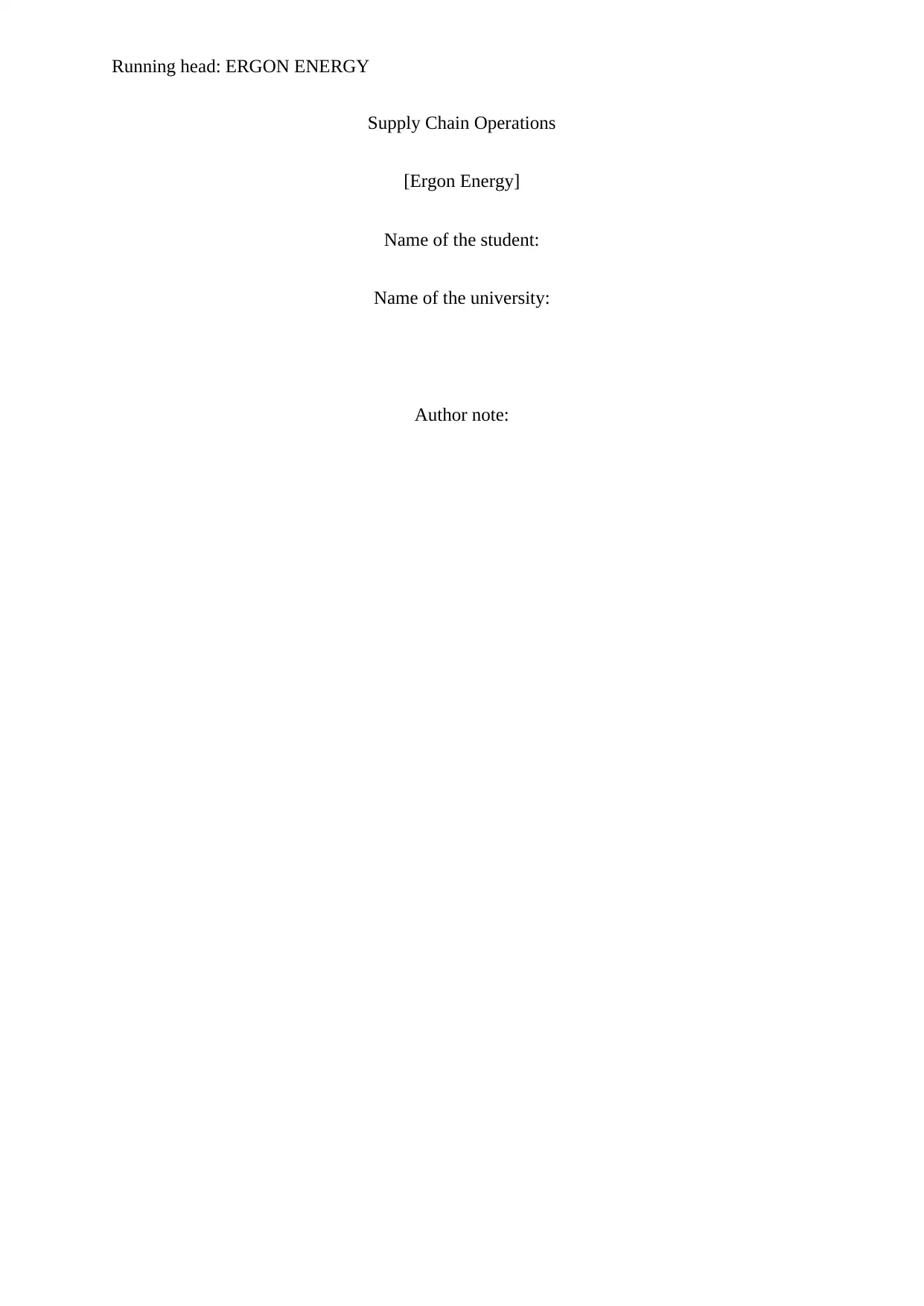
Running head: ERGON ENERGY
Supply Chain Operations
[Ergon Energy]
Name of the student:
Name of the university:
Author note:
Supply Chain Operations
[Ergon Energy]
Name of the student:
Name of the university:
Author note:
Paraphrase This Document
Need a fresh take? Get an instant paraphrase of this document with our AI Paraphraser
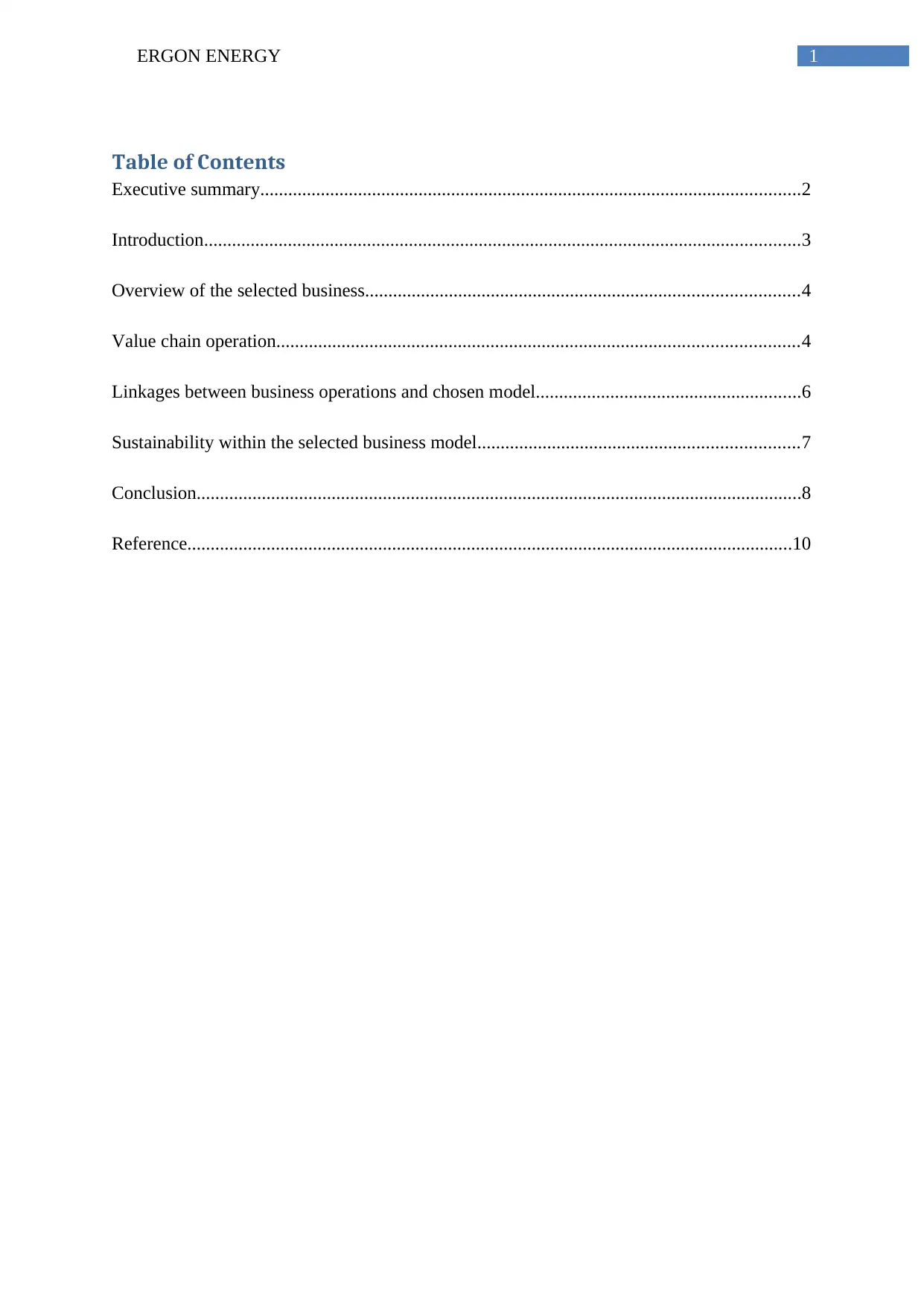
1ERGON ENERGY
Table of Contents
Executive summary....................................................................................................................2
Introduction................................................................................................................................3
Overview of the selected business.............................................................................................4
Value chain operation................................................................................................................4
Linkages between business operations and chosen model.........................................................6
Sustainability within the selected business model.....................................................................7
Conclusion..................................................................................................................................8
Reference..................................................................................................................................10
Table of Contents
Executive summary....................................................................................................................2
Introduction................................................................................................................................3
Overview of the selected business.............................................................................................4
Value chain operation................................................................................................................4
Linkages between business operations and chosen model.........................................................6
Sustainability within the selected business model.....................................................................7
Conclusion..................................................................................................................................8
Reference..................................................................................................................................10
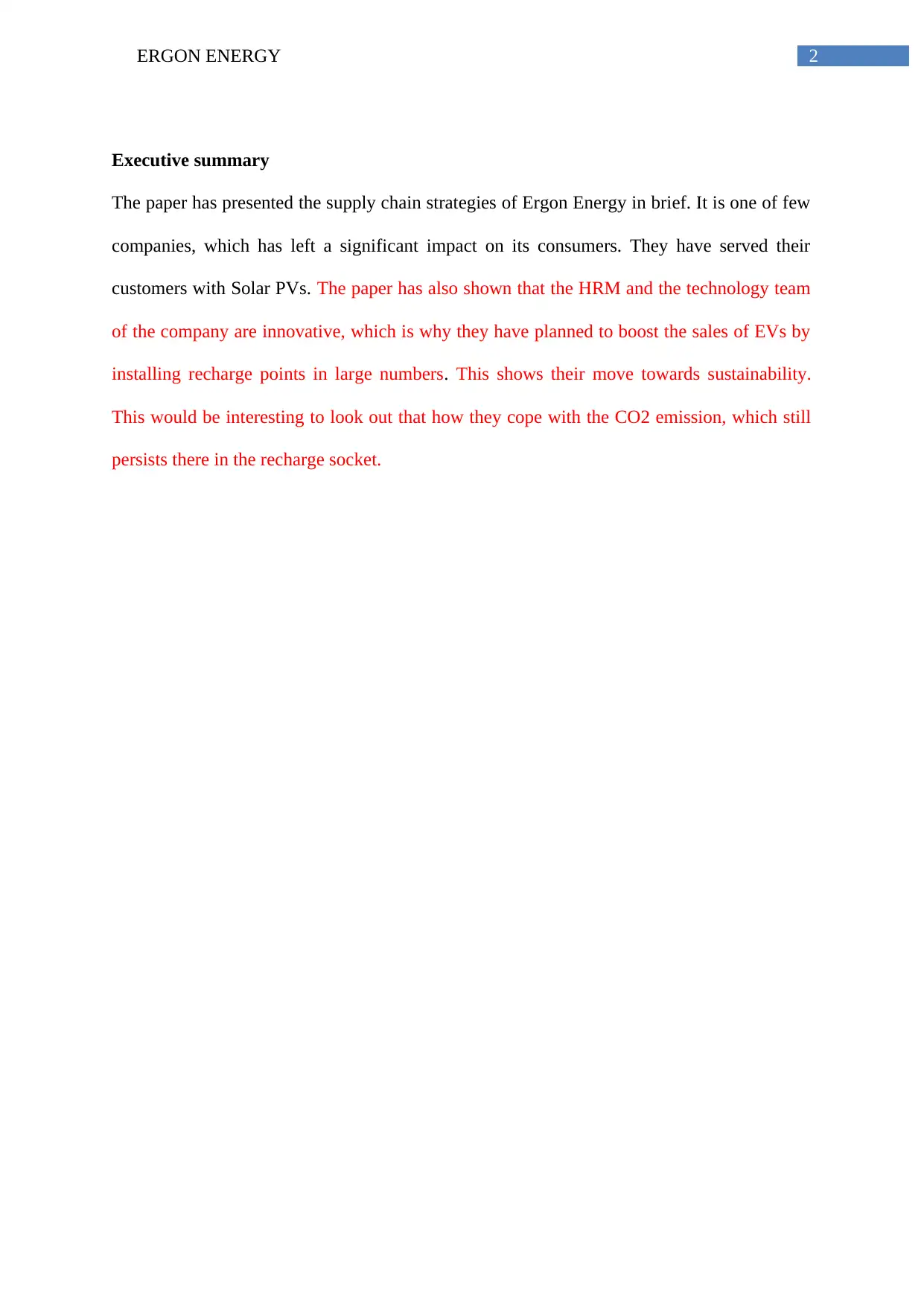
2ERGON ENERGY
Executive summary
The paper has presented the supply chain strategies of Ergon Energy in brief. It is one of few
companies, which has left a significant impact on its consumers. They have served their
customers with Solar PVs. The paper has also shown that the HRM and the technology team
of the company are innovative, which is why they have planned to boost the sales of EVs by
installing recharge points in large numbers. This shows their move towards sustainability.
This would be interesting to look out that how they cope with the CO2 emission, which still
persists there in the recharge socket.
Executive summary
The paper has presented the supply chain strategies of Ergon Energy in brief. It is one of few
companies, which has left a significant impact on its consumers. They have served their
customers with Solar PVs. The paper has also shown that the HRM and the technology team
of the company are innovative, which is why they have planned to boost the sales of EVs by
installing recharge points in large numbers. This shows their move towards sustainability.
This would be interesting to look out that how they cope with the CO2 emission, which still
persists there in the recharge socket.
⊘ This is a preview!⊘
Do you want full access?
Subscribe today to unlock all pages.

Trusted by 1+ million students worldwide
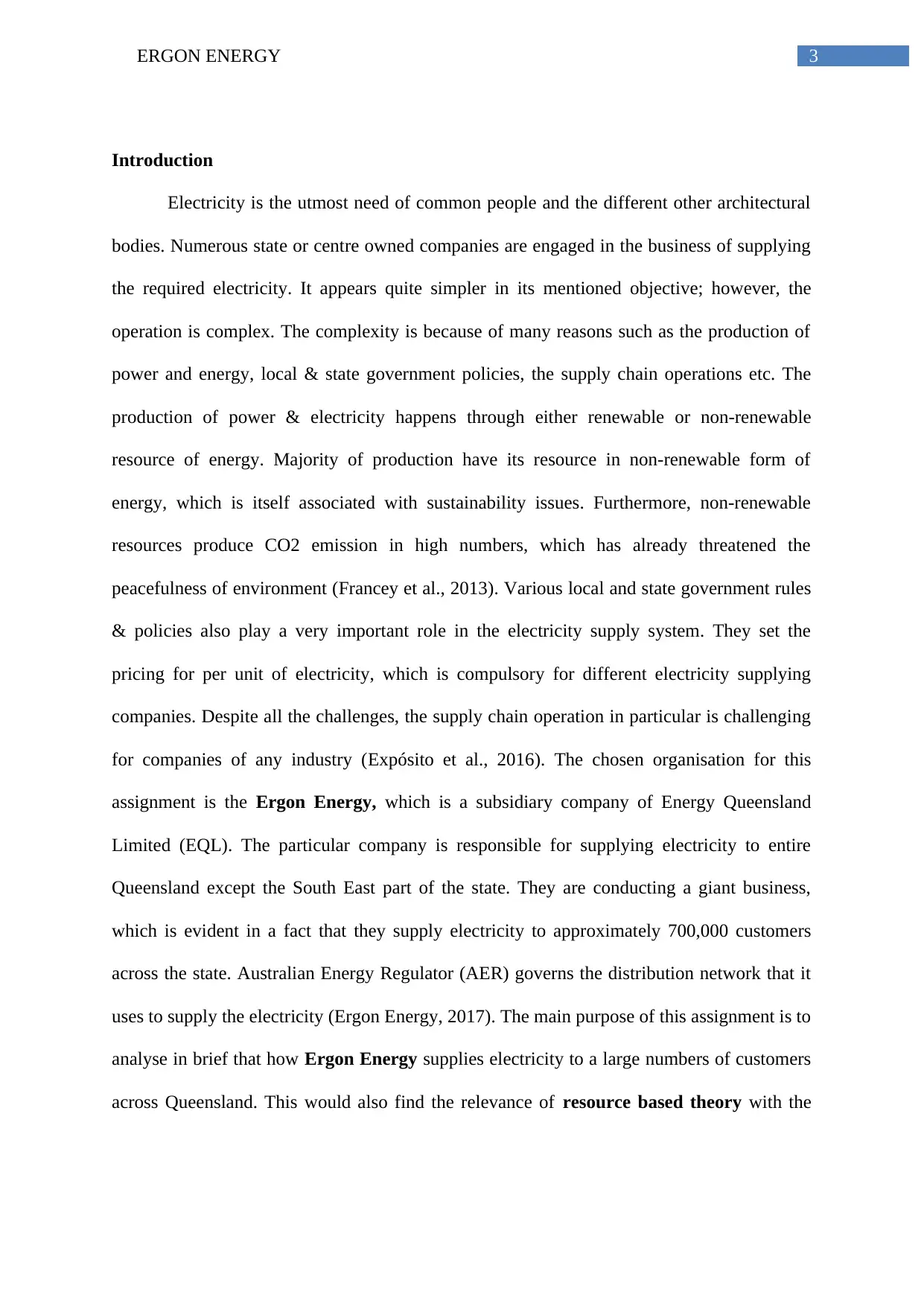
3ERGON ENERGY
Introduction
Electricity is the utmost need of common people and the different other architectural
bodies. Numerous state or centre owned companies are engaged in the business of supplying
the required electricity. It appears quite simpler in its mentioned objective; however, the
operation is complex. The complexity is because of many reasons such as the production of
power and energy, local & state government policies, the supply chain operations etc. The
production of power & electricity happens through either renewable or non-renewable
resource of energy. Majority of production have its resource in non-renewable form of
energy, which is itself associated with sustainability issues. Furthermore, non-renewable
resources produce CO2 emission in high numbers, which has already threatened the
peacefulness of environment (Francey et al., 2013). Various local and state government rules
& policies also play a very important role in the electricity supply system. They set the
pricing for per unit of electricity, which is compulsory for different electricity supplying
companies. Despite all the challenges, the supply chain operation in particular is challenging
for companies of any industry (Expósito et al., 2016). The chosen organisation for this
assignment is the Ergon Energy, which is a subsidiary company of Energy Queensland
Limited (EQL). The particular company is responsible for supplying electricity to entire
Queensland except the South East part of the state. They are conducting a giant business,
which is evident in a fact that they supply electricity to approximately 700,000 customers
across the state. Australian Energy Regulator (AER) governs the distribution network that it
uses to supply the electricity (Ergon Energy, 2017). The main purpose of this assignment is to
analyse in brief that how Ergon Energy supplies electricity to a large numbers of customers
across Queensland. This would also find the relevance of resource based theory with the
Introduction
Electricity is the utmost need of common people and the different other architectural
bodies. Numerous state or centre owned companies are engaged in the business of supplying
the required electricity. It appears quite simpler in its mentioned objective; however, the
operation is complex. The complexity is because of many reasons such as the production of
power and energy, local & state government policies, the supply chain operations etc. The
production of power & electricity happens through either renewable or non-renewable
resource of energy. Majority of production have its resource in non-renewable form of
energy, which is itself associated with sustainability issues. Furthermore, non-renewable
resources produce CO2 emission in high numbers, which has already threatened the
peacefulness of environment (Francey et al., 2013). Various local and state government rules
& policies also play a very important role in the electricity supply system. They set the
pricing for per unit of electricity, which is compulsory for different electricity supplying
companies. Despite all the challenges, the supply chain operation in particular is challenging
for companies of any industry (Expósito et al., 2016). The chosen organisation for this
assignment is the Ergon Energy, which is a subsidiary company of Energy Queensland
Limited (EQL). The particular company is responsible for supplying electricity to entire
Queensland except the South East part of the state. They are conducting a giant business,
which is evident in a fact that they supply electricity to approximately 700,000 customers
across the state. Australian Energy Regulator (AER) governs the distribution network that it
uses to supply the electricity (Ergon Energy, 2017). The main purpose of this assignment is to
analyse in brief that how Ergon Energy supplies electricity to a large numbers of customers
across Queensland. This would also find the relevance of resource based theory with the
Paraphrase This Document
Need a fresh take? Get an instant paraphrase of this document with our AI Paraphraser
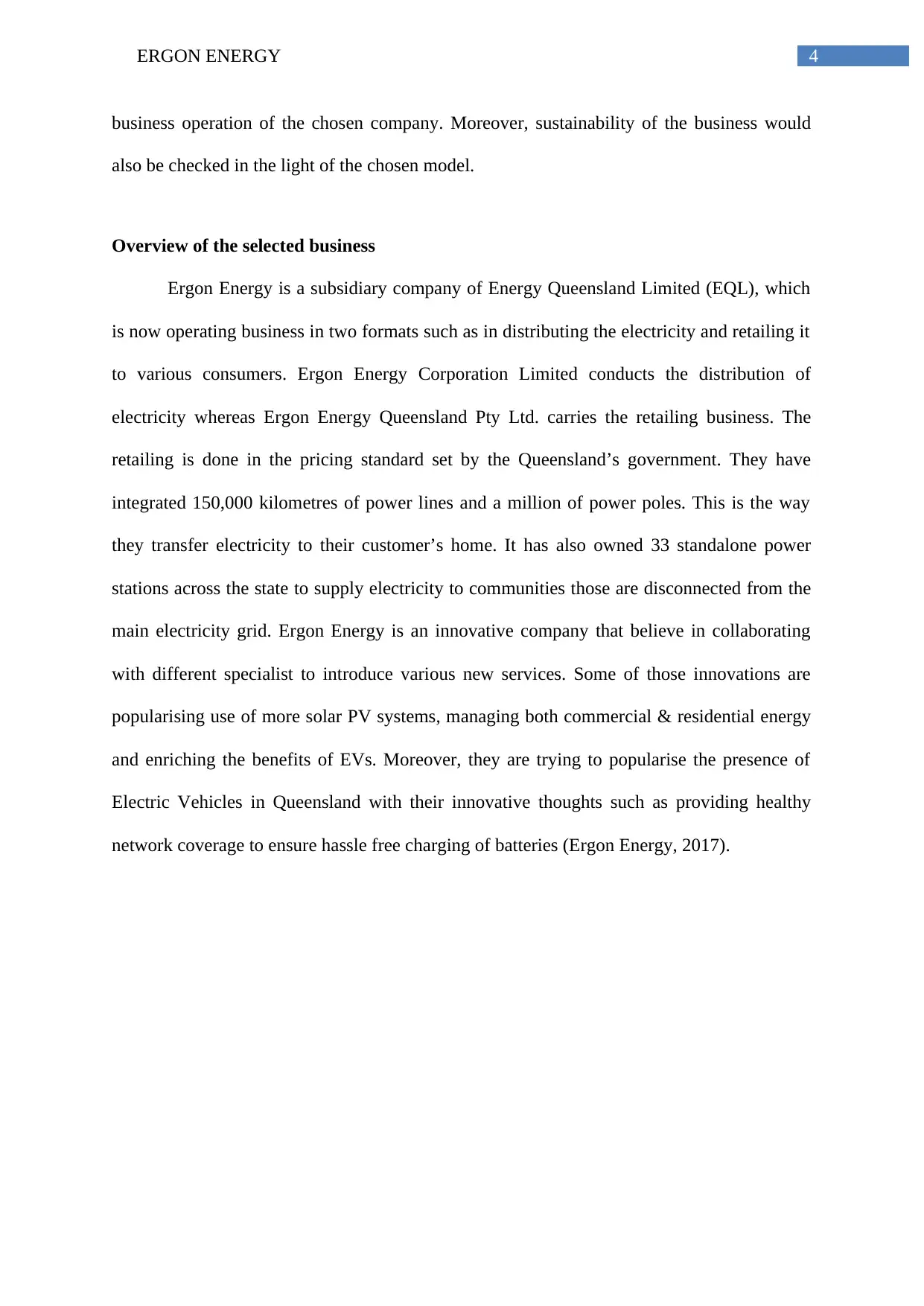
4ERGON ENERGY
business operation of the chosen company. Moreover, sustainability of the business would
also be checked in the light of the chosen model.
Overview of the selected business
Ergon Energy is a subsidiary company of Energy Queensland Limited (EQL), which
is now operating business in two formats such as in distributing the electricity and retailing it
to various consumers. Ergon Energy Corporation Limited conducts the distribution of
electricity whereas Ergon Energy Queensland Pty Ltd. carries the retailing business. The
retailing is done in the pricing standard set by the Queensland’s government. They have
integrated 150,000 kilometres of power lines and a million of power poles. This is the way
they transfer electricity to their customer’s home. It has also owned 33 standalone power
stations across the state to supply electricity to communities those are disconnected from the
main electricity grid. Ergon Energy is an innovative company that believe in collaborating
with different specialist to introduce various new services. Some of those innovations are
popularising use of more solar PV systems, managing both commercial & residential energy
and enriching the benefits of EVs. Moreover, they are trying to popularise the presence of
Electric Vehicles in Queensland with their innovative thoughts such as providing healthy
network coverage to ensure hassle free charging of batteries (Ergon Energy, 2017).
business operation of the chosen company. Moreover, sustainability of the business would
also be checked in the light of the chosen model.
Overview of the selected business
Ergon Energy is a subsidiary company of Energy Queensland Limited (EQL), which
is now operating business in two formats such as in distributing the electricity and retailing it
to various consumers. Ergon Energy Corporation Limited conducts the distribution of
electricity whereas Ergon Energy Queensland Pty Ltd. carries the retailing business. The
retailing is done in the pricing standard set by the Queensland’s government. They have
integrated 150,000 kilometres of power lines and a million of power poles. This is the way
they transfer electricity to their customer’s home. It has also owned 33 standalone power
stations across the state to supply electricity to communities those are disconnected from the
main electricity grid. Ergon Energy is an innovative company that believe in collaborating
with different specialist to introduce various new services. Some of those innovations are
popularising use of more solar PV systems, managing both commercial & residential energy
and enriching the benefits of EVs. Moreover, they are trying to popularise the presence of
Electric Vehicles in Queensland with their innovative thoughts such as providing healthy
network coverage to ensure hassle free charging of batteries (Ergon Energy, 2017).
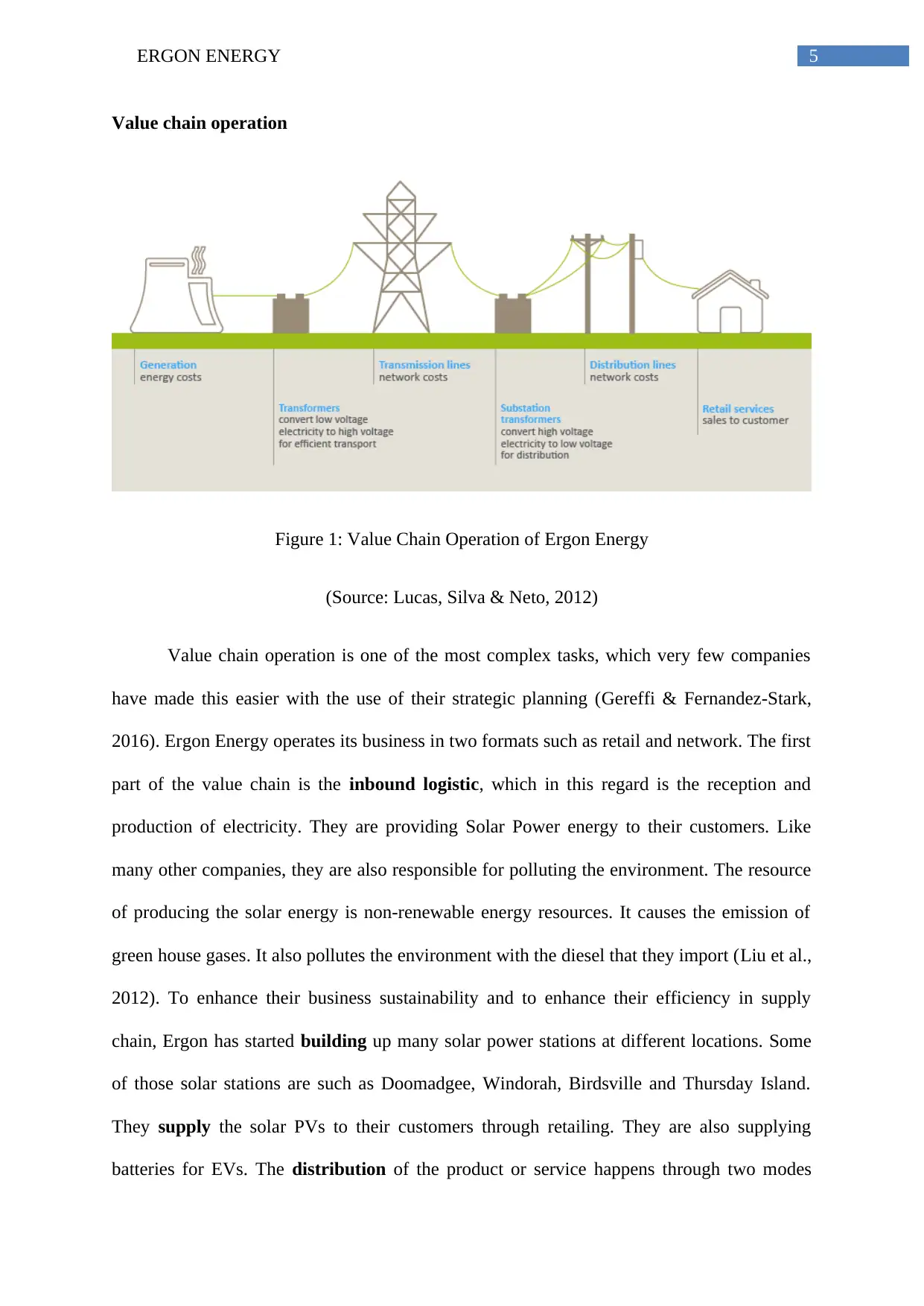
5ERGON ENERGY
Value chain operation
Figure 1: Value Chain Operation of Ergon Energy
(Source: Lucas, Silva & Neto, 2012)
Value chain operation is one of the most complex tasks, which very few companies
have made this easier with the use of their strategic planning (Gereffi & Fernandez-Stark,
2016). Ergon Energy operates its business in two formats such as retail and network. The first
part of the value chain is the inbound logistic, which in this regard is the reception and
production of electricity. They are providing Solar Power energy to their customers. Like
many other companies, they are also responsible for polluting the environment. The resource
of producing the solar energy is non-renewable energy resources. It causes the emission of
green house gases. It also pollutes the environment with the diesel that they import (Liu et al.,
2012). To enhance their business sustainability and to enhance their efficiency in supply
chain, Ergon has started building up many solar power stations at different locations. Some
of those solar stations are such as Doomadgee, Windorah, Birdsville and Thursday Island.
They supply the solar PVs to their customers through retailing. They are also supplying
batteries for EVs. The distribution of the product or service happens through two modes
Value chain operation
Figure 1: Value Chain Operation of Ergon Energy
(Source: Lucas, Silva & Neto, 2012)
Value chain operation is one of the most complex tasks, which very few companies
have made this easier with the use of their strategic planning (Gereffi & Fernandez-Stark,
2016). Ergon Energy operates its business in two formats such as retail and network. The first
part of the value chain is the inbound logistic, which in this regard is the reception and
production of electricity. They are providing Solar Power energy to their customers. Like
many other companies, they are also responsible for polluting the environment. The resource
of producing the solar energy is non-renewable energy resources. It causes the emission of
green house gases. It also pollutes the environment with the diesel that they import (Liu et al.,
2012). To enhance their business sustainability and to enhance their efficiency in supply
chain, Ergon has started building up many solar power stations at different locations. Some
of those solar stations are such as Doomadgee, Windorah, Birdsville and Thursday Island.
They supply the solar PVs to their customers through retailing. They are also supplying
batteries for EVs. The distribution of the product or service happens through two modes
⊘ This is a preview!⊘
Do you want full access?
Subscribe today to unlock all pages.

Trusted by 1+ million students worldwide
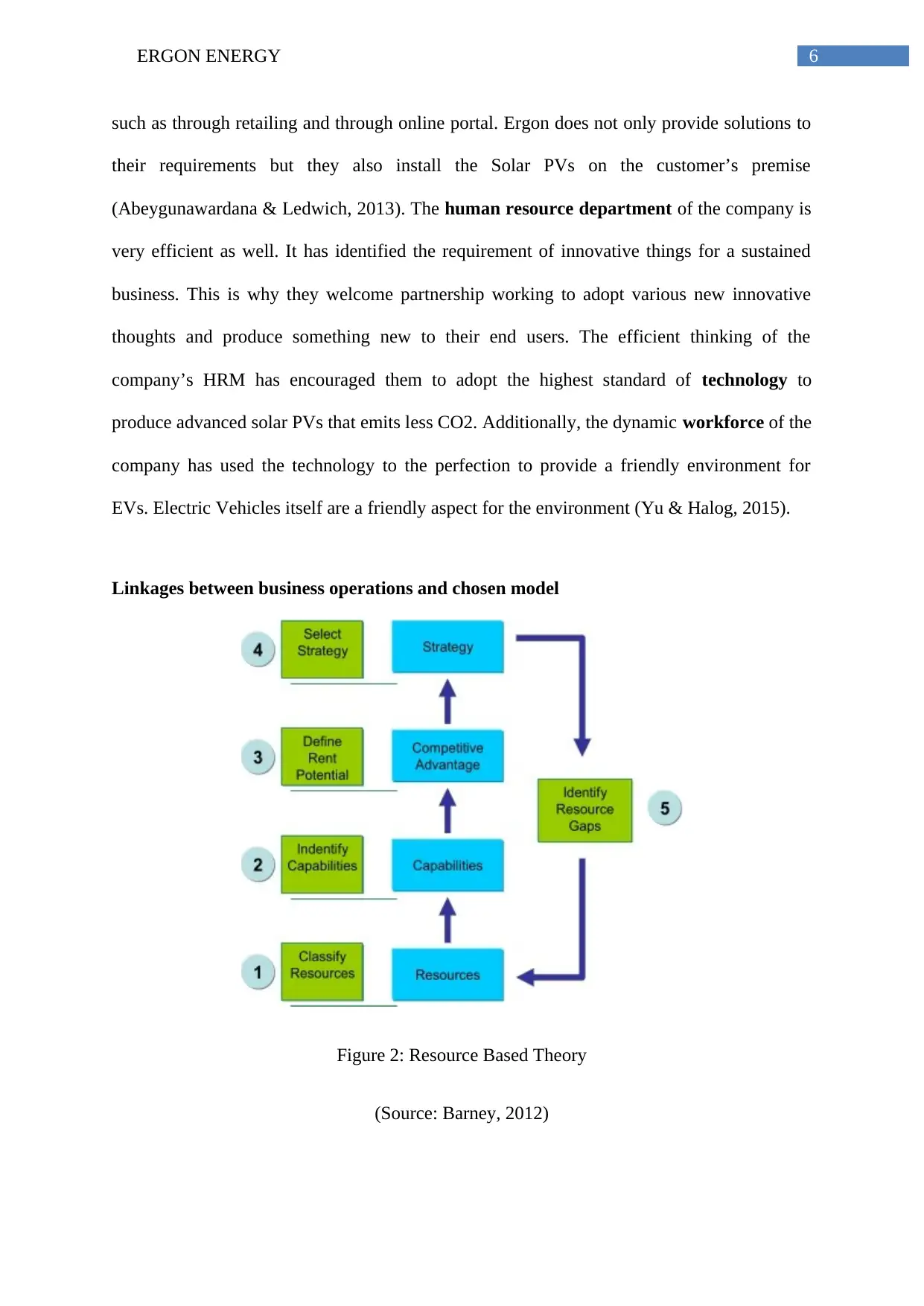
6ERGON ENERGY
such as through retailing and through online portal. Ergon does not only provide solutions to
their requirements but they also install the Solar PVs on the customer’s premise
(Abeygunawardana & Ledwich, 2013). The human resource department of the company is
very efficient as well. It has identified the requirement of innovative things for a sustained
business. This is why they welcome partnership working to adopt various new innovative
thoughts and produce something new to their end users. The efficient thinking of the
company’s HRM has encouraged them to adopt the highest standard of technology to
produce advanced solar PVs that emits less CO2. Additionally, the dynamic workforce of the
company has used the technology to the perfection to provide a friendly environment for
EVs. Electric Vehicles itself are a friendly aspect for the environment (Yu & Halog, 2015).
Linkages between business operations and chosen model
Figure 2: Resource Based Theory
(Source: Barney, 2012)
such as through retailing and through online portal. Ergon does not only provide solutions to
their requirements but they also install the Solar PVs on the customer’s premise
(Abeygunawardana & Ledwich, 2013). The human resource department of the company is
very efficient as well. It has identified the requirement of innovative things for a sustained
business. This is why they welcome partnership working to adopt various new innovative
thoughts and produce something new to their end users. The efficient thinking of the
company’s HRM has encouraged them to adopt the highest standard of technology to
produce advanced solar PVs that emits less CO2. Additionally, the dynamic workforce of the
company has used the technology to the perfection to provide a friendly environment for
EVs. Electric Vehicles itself are a friendly aspect for the environment (Yu & Halog, 2015).
Linkages between business operations and chosen model
Figure 2: Resource Based Theory
(Source: Barney, 2012)
Paraphrase This Document
Need a fresh take? Get an instant paraphrase of this document with our AI Paraphraser
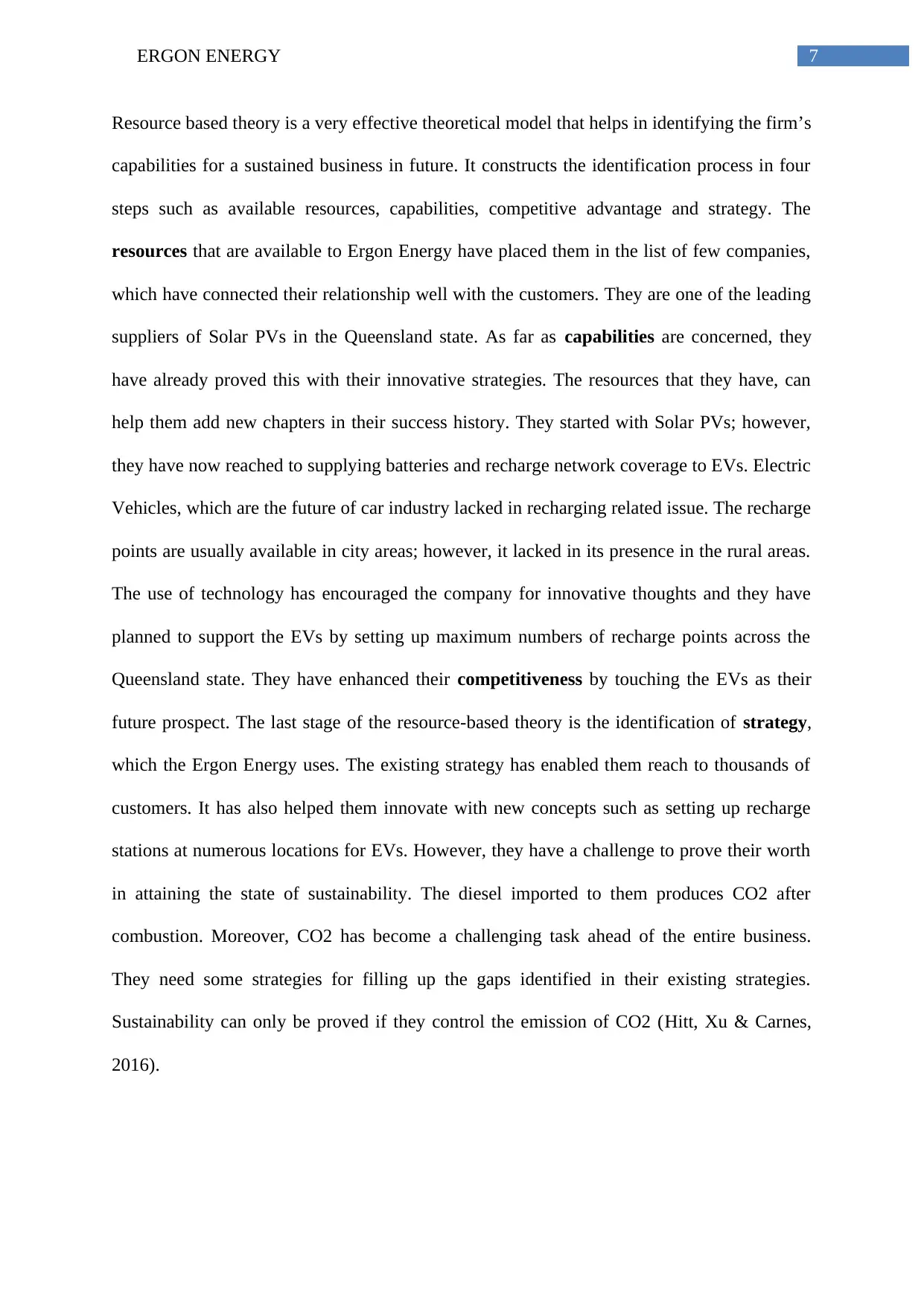
7ERGON ENERGY
Resource based theory is a very effective theoretical model that helps in identifying the firm’s
capabilities for a sustained business in future. It constructs the identification process in four
steps such as available resources, capabilities, competitive advantage and strategy. The
resources that are available to Ergon Energy have placed them in the list of few companies,
which have connected their relationship well with the customers. They are one of the leading
suppliers of Solar PVs in the Queensland state. As far as capabilities are concerned, they
have already proved this with their innovative strategies. The resources that they have, can
help them add new chapters in their success history. They started with Solar PVs; however,
they have now reached to supplying batteries and recharge network coverage to EVs. Electric
Vehicles, which are the future of car industry lacked in recharging related issue. The recharge
points are usually available in city areas; however, it lacked in its presence in the rural areas.
The use of technology has encouraged the company for innovative thoughts and they have
planned to support the EVs by setting up maximum numbers of recharge points across the
Queensland state. They have enhanced their competitiveness by touching the EVs as their
future prospect. The last stage of the resource-based theory is the identification of strategy,
which the Ergon Energy uses. The existing strategy has enabled them reach to thousands of
customers. It has also helped them innovate with new concepts such as setting up recharge
stations at numerous locations for EVs. However, they have a challenge to prove their worth
in attaining the state of sustainability. The diesel imported to them produces CO2 after
combustion. Moreover, CO2 has become a challenging task ahead of the entire business.
They need some strategies for filling up the gaps identified in their existing strategies.
Sustainability can only be proved if they control the emission of CO2 (Hitt, Xu & Carnes,
2016).
Resource based theory is a very effective theoretical model that helps in identifying the firm’s
capabilities for a sustained business in future. It constructs the identification process in four
steps such as available resources, capabilities, competitive advantage and strategy. The
resources that are available to Ergon Energy have placed them in the list of few companies,
which have connected their relationship well with the customers. They are one of the leading
suppliers of Solar PVs in the Queensland state. As far as capabilities are concerned, they
have already proved this with their innovative strategies. The resources that they have, can
help them add new chapters in their success history. They started with Solar PVs; however,
they have now reached to supplying batteries and recharge network coverage to EVs. Electric
Vehicles, which are the future of car industry lacked in recharging related issue. The recharge
points are usually available in city areas; however, it lacked in its presence in the rural areas.
The use of technology has encouraged the company for innovative thoughts and they have
planned to support the EVs by setting up maximum numbers of recharge points across the
Queensland state. They have enhanced their competitiveness by touching the EVs as their
future prospect. The last stage of the resource-based theory is the identification of strategy,
which the Ergon Energy uses. The existing strategy has enabled them reach to thousands of
customers. It has also helped them innovate with new concepts such as setting up recharge
stations at numerous locations for EVs. However, they have a challenge to prove their worth
in attaining the state of sustainability. The diesel imported to them produces CO2 after
combustion. Moreover, CO2 has become a challenging task ahead of the entire business.
They need some strategies for filling up the gaps identified in their existing strategies.
Sustainability can only be proved if they control the emission of CO2 (Hitt, Xu & Carnes,
2016).
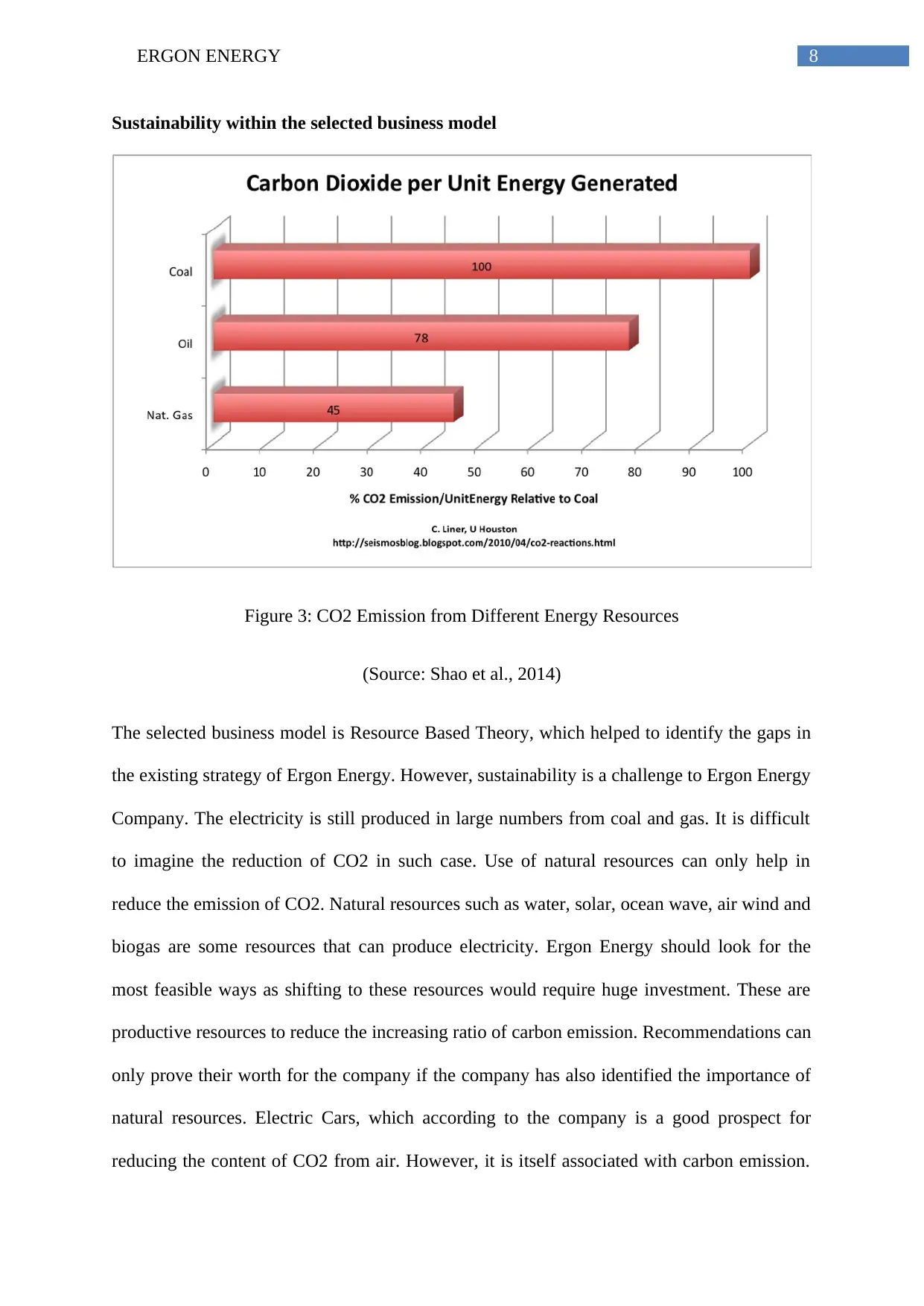
8ERGON ENERGY
Sustainability within the selected business model
Figure 3: CO2 Emission from Different Energy Resources
(Source: Shao et al., 2014)
The selected business model is Resource Based Theory, which helped to identify the gaps in
the existing strategy of Ergon Energy. However, sustainability is a challenge to Ergon Energy
Company. The electricity is still produced in large numbers from coal and gas. It is difficult
to imagine the reduction of CO2 in such case. Use of natural resources can only help in
reduce the emission of CO2. Natural resources such as water, solar, ocean wave, air wind and
biogas are some resources that can produce electricity. Ergon Energy should look for the
most feasible ways as shifting to these resources would require huge investment. These are
productive resources to reduce the increasing ratio of carbon emission. Recommendations can
only prove their worth for the company if the company has also identified the importance of
natural resources. Electric Cars, which according to the company is a good prospect for
reducing the content of CO2 from air. However, it is itself associated with carbon emission.
Sustainability within the selected business model
Figure 3: CO2 Emission from Different Energy Resources
(Source: Shao et al., 2014)
The selected business model is Resource Based Theory, which helped to identify the gaps in
the existing strategy of Ergon Energy. However, sustainability is a challenge to Ergon Energy
Company. The electricity is still produced in large numbers from coal and gas. It is difficult
to imagine the reduction of CO2 in such case. Use of natural resources can only help in
reduce the emission of CO2. Natural resources such as water, solar, ocean wave, air wind and
biogas are some resources that can produce electricity. Ergon Energy should look for the
most feasible ways as shifting to these resources would require huge investment. These are
productive resources to reduce the increasing ratio of carbon emission. Recommendations can
only prove their worth for the company if the company has also identified the importance of
natural resources. Electric Cars, which according to the company is a good prospect for
reducing the content of CO2 from air. However, it is itself associated with carbon emission.
⊘ This is a preview!⊘
Do you want full access?
Subscribe today to unlock all pages.

Trusted by 1+ million students worldwide
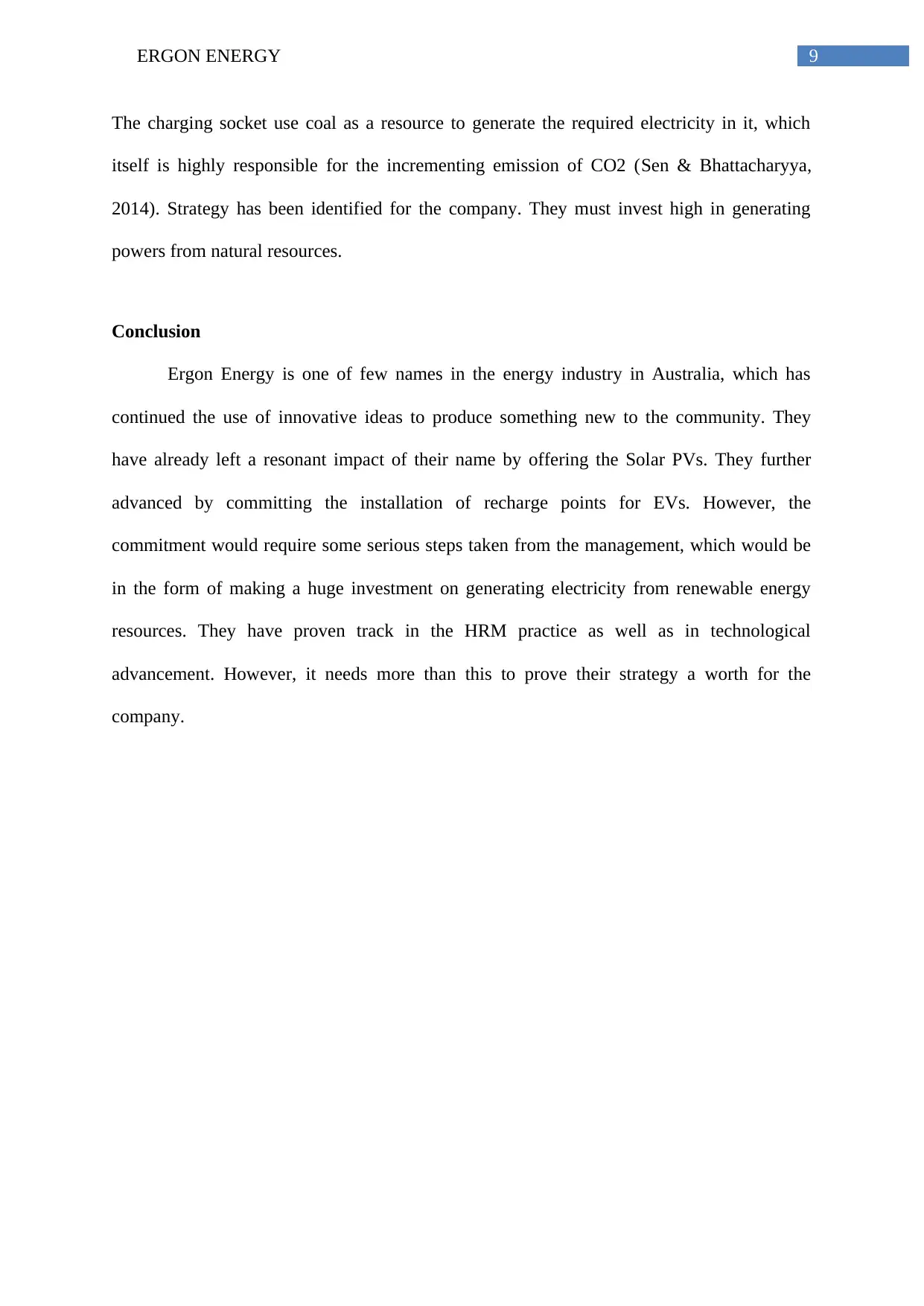
9ERGON ENERGY
The charging socket use coal as a resource to generate the required electricity in it, which
itself is highly responsible for the incrementing emission of CO2 (Sen & Bhattacharyya,
2014). Strategy has been identified for the company. They must invest high in generating
powers from natural resources.
Conclusion
Ergon Energy is one of few names in the energy industry in Australia, which has
continued the use of innovative ideas to produce something new to the community. They
have already left a resonant impact of their name by offering the Solar PVs. They further
advanced by committing the installation of recharge points for EVs. However, the
commitment would require some serious steps taken from the management, which would be
in the form of making a huge investment on generating electricity from renewable energy
resources. They have proven track in the HRM practice as well as in technological
advancement. However, it needs more than this to prove their strategy a worth for the
company.
The charging socket use coal as a resource to generate the required electricity in it, which
itself is highly responsible for the incrementing emission of CO2 (Sen & Bhattacharyya,
2014). Strategy has been identified for the company. They must invest high in generating
powers from natural resources.
Conclusion
Ergon Energy is one of few names in the energy industry in Australia, which has
continued the use of innovative ideas to produce something new to the community. They
have already left a resonant impact of their name by offering the Solar PVs. They further
advanced by committing the installation of recharge points for EVs. However, the
commitment would require some serious steps taken from the management, which would be
in the form of making a huge investment on generating electricity from renewable energy
resources. They have proven track in the HRM practice as well as in technological
advancement. However, it needs more than this to prove their strategy a worth for the
company.
Paraphrase This Document
Need a fresh take? Get an instant paraphrase of this document with our AI Paraphraser
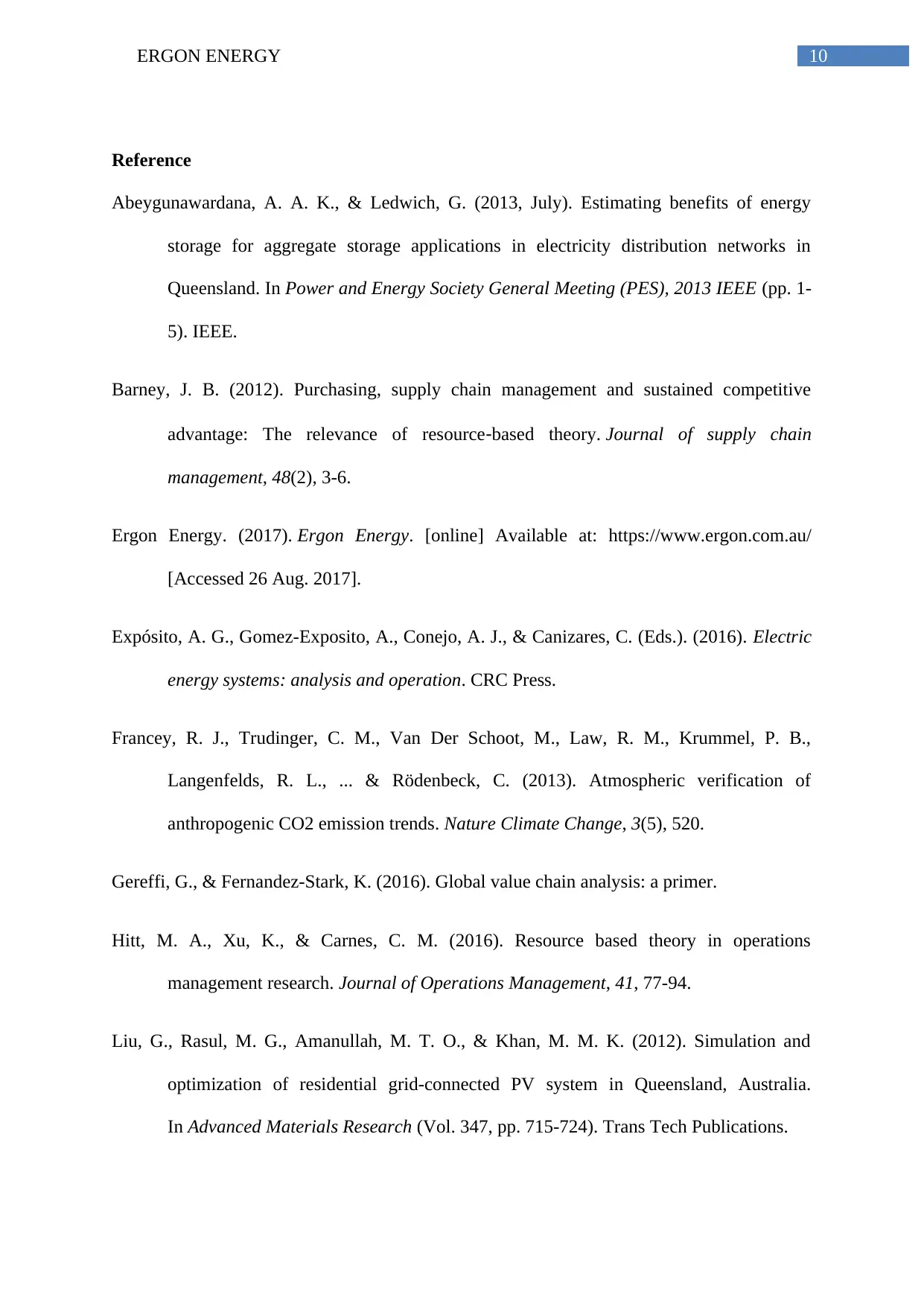
10ERGON ENERGY
Reference
Abeygunawardana, A. A. K., & Ledwich, G. (2013, July). Estimating benefits of energy
storage for aggregate storage applications in electricity distribution networks in
Queensland. In Power and Energy Society General Meeting (PES), 2013 IEEE (pp. 1-
5). IEEE.
Barney, J. B. (2012). Purchasing, supply chain management and sustained competitive
advantage: The relevance of resource‐based theory. Journal of supply chain
management, 48(2), 3-6.
Ergon Energy. (2017). Ergon Energy. [online] Available at: https://www.ergon.com.au/
[Accessed 26 Aug. 2017].
Expósito, A. G., Gomez-Exposito, A., Conejo, A. J., & Canizares, C. (Eds.). (2016). Electric
energy systems: analysis and operation. CRC Press.
Francey, R. J., Trudinger, C. M., Van Der Schoot, M., Law, R. M., Krummel, P. B.,
Langenfelds, R. L., ... & Rödenbeck, C. (2013). Atmospheric verification of
anthropogenic CO2 emission trends. Nature Climate Change, 3(5), 520.
Gereffi, G., & Fernandez-Stark, K. (2016). Global value chain analysis: a primer.
Hitt, M. A., Xu, K., & Carnes, C. M. (2016). Resource based theory in operations
management research. Journal of Operations Management, 41, 77-94.
Liu, G., Rasul, M. G., Amanullah, M. T. O., & Khan, M. M. K. (2012). Simulation and
optimization of residential grid-connected PV system in Queensland, Australia.
In Advanced Materials Research (Vol. 347, pp. 715-724). Trans Tech Publications.
Reference
Abeygunawardana, A. A. K., & Ledwich, G. (2013, July). Estimating benefits of energy
storage for aggregate storage applications in electricity distribution networks in
Queensland. In Power and Energy Society General Meeting (PES), 2013 IEEE (pp. 1-
5). IEEE.
Barney, J. B. (2012). Purchasing, supply chain management and sustained competitive
advantage: The relevance of resource‐based theory. Journal of supply chain
management, 48(2), 3-6.
Ergon Energy. (2017). Ergon Energy. [online] Available at: https://www.ergon.com.au/
[Accessed 26 Aug. 2017].
Expósito, A. G., Gomez-Exposito, A., Conejo, A. J., & Canizares, C. (Eds.). (2016). Electric
energy systems: analysis and operation. CRC Press.
Francey, R. J., Trudinger, C. M., Van Der Schoot, M., Law, R. M., Krummel, P. B.,
Langenfelds, R. L., ... & Rödenbeck, C. (2013). Atmospheric verification of
anthropogenic CO2 emission trends. Nature Climate Change, 3(5), 520.
Gereffi, G., & Fernandez-Stark, K. (2016). Global value chain analysis: a primer.
Hitt, M. A., Xu, K., & Carnes, C. M. (2016). Resource based theory in operations
management research. Journal of Operations Management, 41, 77-94.
Liu, G., Rasul, M. G., Amanullah, M. T. O., & Khan, M. M. K. (2012). Simulation and
optimization of residential grid-connected PV system in Queensland, Australia.
In Advanced Materials Research (Vol. 347, pp. 715-724). Trans Tech Publications.
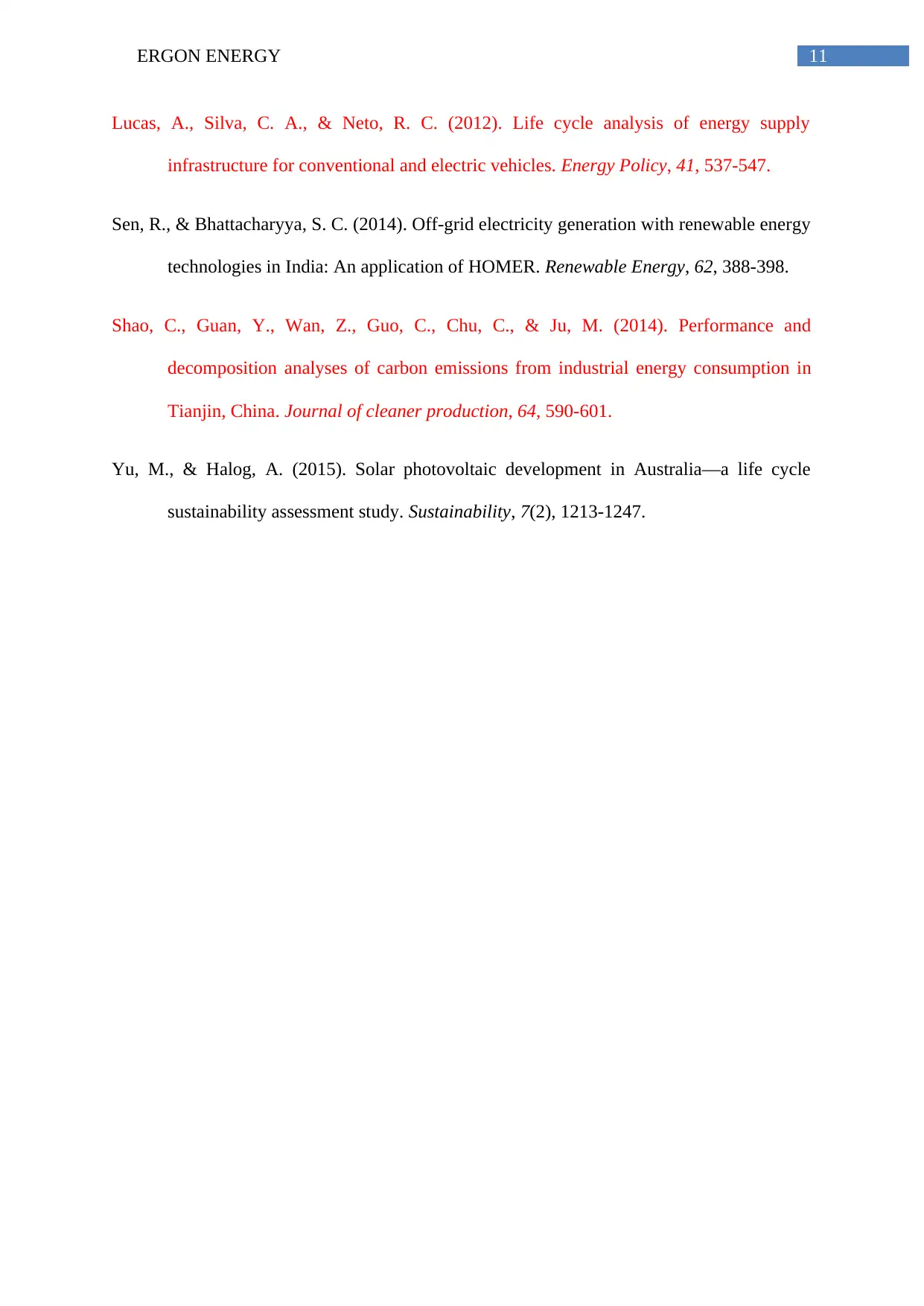
11ERGON ENERGY
Lucas, A., Silva, C. A., & Neto, R. C. (2012). Life cycle analysis of energy supply
infrastructure for conventional and electric vehicles. Energy Policy, 41, 537-547.
Sen, R., & Bhattacharyya, S. C. (2014). Off-grid electricity generation with renewable energy
technologies in India: An application of HOMER. Renewable Energy, 62, 388-398.
Shao, C., Guan, Y., Wan, Z., Guo, C., Chu, C., & Ju, M. (2014). Performance and
decomposition analyses of carbon emissions from industrial energy consumption in
Tianjin, China. Journal of cleaner production, 64, 590-601.
Yu, M., & Halog, A. (2015). Solar photovoltaic development in Australia—a life cycle
sustainability assessment study. Sustainability, 7(2), 1213-1247.
Lucas, A., Silva, C. A., & Neto, R. C. (2012). Life cycle analysis of energy supply
infrastructure for conventional and electric vehicles. Energy Policy, 41, 537-547.
Sen, R., & Bhattacharyya, S. C. (2014). Off-grid electricity generation with renewable energy
technologies in India: An application of HOMER. Renewable Energy, 62, 388-398.
Shao, C., Guan, Y., Wan, Z., Guo, C., Chu, C., & Ju, M. (2014). Performance and
decomposition analyses of carbon emissions from industrial energy consumption in
Tianjin, China. Journal of cleaner production, 64, 590-601.
Yu, M., & Halog, A. (2015). Solar photovoltaic development in Australia—a life cycle
sustainability assessment study. Sustainability, 7(2), 1213-1247.
⊘ This is a preview!⊘
Do you want full access?
Subscribe today to unlock all pages.

Trusted by 1+ million students worldwide
1 out of 12
Related Documents
Your All-in-One AI-Powered Toolkit for Academic Success.
+13062052269
info@desklib.com
Available 24*7 on WhatsApp / Email
![[object Object]](/_next/static/media/star-bottom.7253800d.svg)
Unlock your academic potential
Copyright © 2020–2025 A2Z Services. All Rights Reserved. Developed and managed by ZUCOL.




